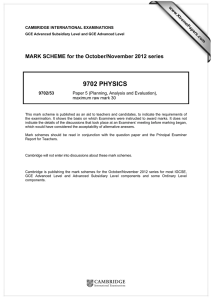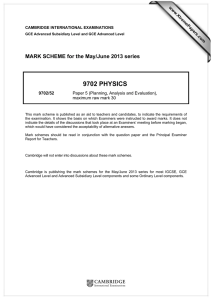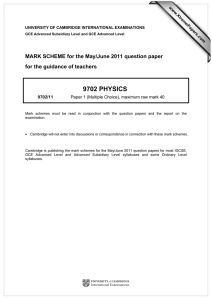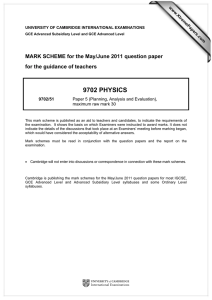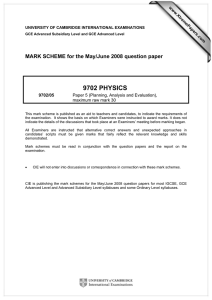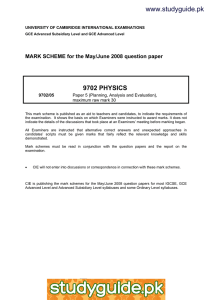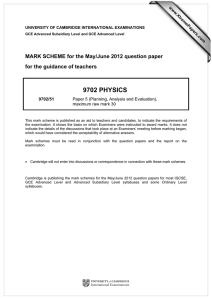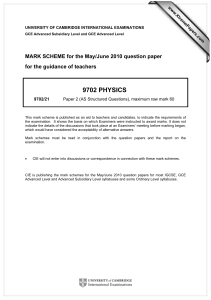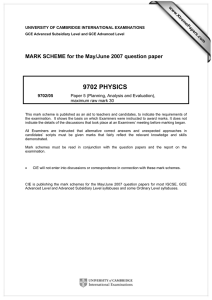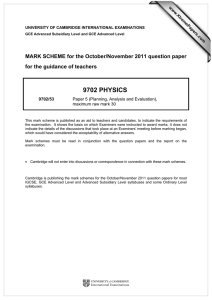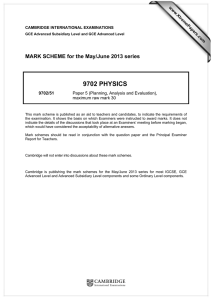9702 PHYSICS MARK SCHEME for the May/June 2012 question paper
advertisement
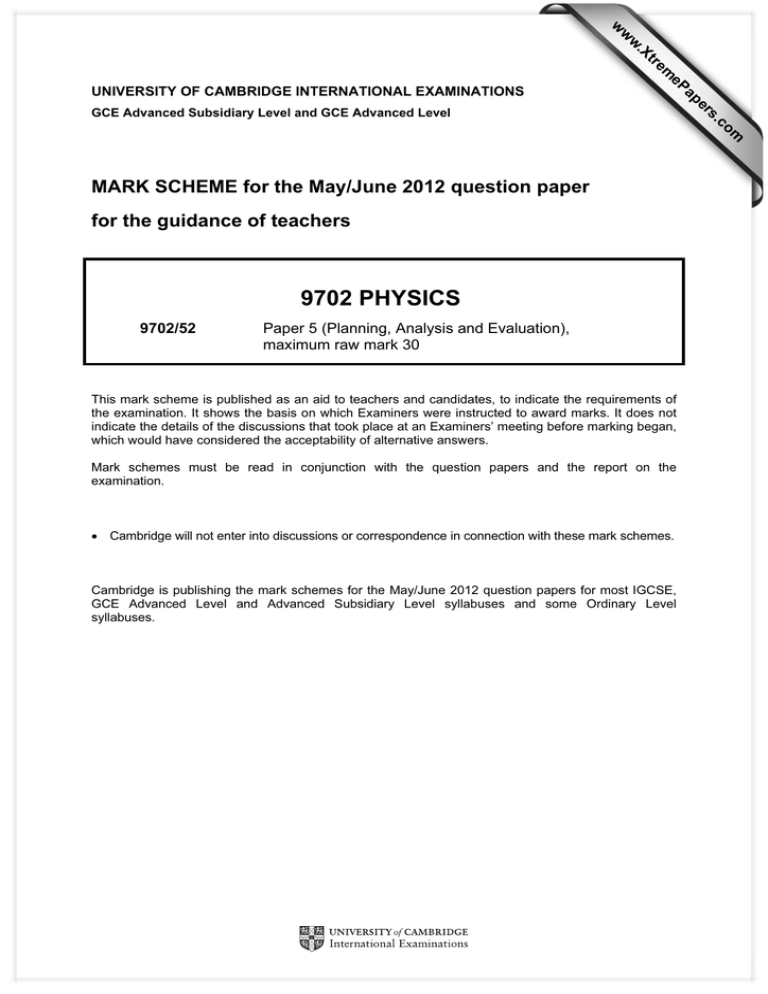
w w ap eP m e tr .X w UNIVERSITY OF CAMBRIDGE INTERNATIONAL EXAMINATIONS for the guidance of teachers 9702 PHYSICS 9702/52 Paper 5 (Planning, Analysis and Evaluation), maximum raw mark 30 This mark scheme is published as an aid to teachers and candidates, to indicate the requirements of the examination. It shows the basis on which Examiners were instructed to award marks. It does not indicate the details of the discussions that took place at an Examiners’ meeting before marking began, which would have considered the acceptability of alternative answers. Mark schemes must be read in conjunction with the question papers and the report on the examination. • Cambridge will not enter into discussions or correspondence in connection with these mark schemes. Cambridge is publishing the mark schemes for the May/June 2012 question papers for most IGCSE, GCE Advanced Level and Advanced Subsidiary Level syllabuses and some Ordinary Level syllabuses. om .c MARK SCHEME for the May/June 2012 question paper s er GCE Advanced Subsidiary Level and GCE Advanced Level Page 2 1 Mark Scheme: Teachers’ version GCE AS/A LEVEL – May/June 2012 Syllabus 9702 Paper 52 Planning (15 marks) Defining the problem (3 marks) P1 v is the independent variable and θ is the dependent variable or vary v and measure θ. [1] P2 Keep the (shape and) size/volume/surface area/mass of balloon/helium constant Do not credit ‘same balloon’. [1] P3 Keep the temperature (air/helium/balloon) constant. [1] Methods of data collection (5 marks) M1 Labelled diagram of apparatus: balloon, string fixed and method of producing wind. Method of producing wind to be approximately horizontal to balloon. [1] M2 Suspend mass from balloon. [1] M3 Method to change wind speed, e.g. change setting, variable power supply/resistor/change distance from fan. [1] M4 Method to measure wind speed, e.g. wind speed indicator/detector, anemometer [1] M5 Method to measure angle – use protractor or rule for measurements for trigonometry methods. This must be shown correctly on diagram or explained in text. [1] Method of analysis (2 marks) A1 Plot a graph of tan θ against 1/v2. [1] A2 Relationship valid if straight line through origin [1] Safety considerations (1 mark) S1 Avoid the moving blades of the fan (safety screen, switch off when changing experiment); goggles to avoid air stream into eye. [1] Additional detail (4 marks) D1/2/3/4 Relevant points might include 1 Large wind speed to produce measurable deflection/large cross-sectional area of balloon. 2 Additional detail on measuring angle e.g. use a large protractor, projection method. 3 tan θ = h/l. 4 Measuring air speed at point where balloon is positioned. 5 Adjust height of fan so that air flow is horizontally aligned to the balloon. 6 Reason for adding mass to increase stability/deflection. 7 Keep windows shut/air conditioning switched off/use of wind tunnel to avoid draughts. 8 Wait for the balloon to become stable. [4] Do not allow vague computer methods. [Total: 15] © University of Cambridge International Examinations 2012 Page 3 2 Mark Scheme: Teachers’ version GCE AS/A LEVEL – May/June 2012 Syllabus 9702 Paper 52 Analysis, conclusions and evaluation (15 marks) Part Mark Expected Answer Additional Guidance (a) A1 (b) T1 1/L / m–1 or (1/L) / m–1 Allow 1/L (m–1), 1/L / 1/m, 1/L (1/m) T2 1.83 or 1.835 2.08 or 2.083 2.35 or 2.353 2.50 or 2.500 2.82 or 2.817 3.13 or 3.125 Values must correspond to table. A mixture of 3 s.f. and 4 s.f. is allowed U1 From ± 0.01 or ± 0.02, to ± 0.05 Allow more than one significant figure. G1 Six points plotted correctly Must be within half a small square. Penalise ‘blobs’ (more than half a small square). Ecf allowed from table. U2 All Error bars in 1/L/m–1 plotted correctly. Check second and last point for accuracy. Must be accurate within half a small square. G2 Line of best fit If points are plotted correctly then lower end of line should pass between (1.8, 250) and (1.8, 254) and upper end of line should pass between (3.18, 450) and (3.2, 448). Allow ecf from points plotted incorrectly – examiner judgement. G3 Worst acceptable straight line. Steepest or shallowest possible line that passes through all the error bars. Line should be clearly labelled or dashed. Should pass from left of top error bar to right of bottom error bar or right of top error bar to left of bottom error bar. Mark scored only if all error bars are plotted. C1 Gradient of best fit line The triangle used should be at least half the length of the drawn line. Check the read offs. Work to half a small square. Do not penalise POT. (Should be about 140) U3 Uncertainty in gradient Method of determining absolute uncertainty Difference in worst gradient and gradient. C2 Value of µ using gradient µ = 7.5/gradient2 (c) (i) (ii) (iii) (d) (i) Gradient = 1 T 2 µ Allow equivalent, e.g. T 4µ Gradient must be used. (Should be about 0.00037 or 3.7 × 10–4) (ii) C3 kg m–1 or N Hz–2 m–2 Allow other correct units e.g. N s2 m–2 or Pa s2 or N (Hz m)–2 U4 10% + 2 × percentage uncertainty in gradient Check working. Must be larger than 10%. © University of Cambridge International Examinations 2012 Page 4 (e) Mark Scheme: Teachers’ version GCE AS/A LEVEL – May/June 2012 Syllabus 9702 C4 r given to 2 or 3 s.f. and in the range 1.15 × 10–4 to 1.18 × 10–4 Allow 1.2 to 2 s.f. Penalise 1 s.f. or >3 s.f. U5 (d)(ii) / 2 Check working if not (d)(ii) / 2 Paper 52 [Total: 15] Uncertainties in Question 2 (c) (iii) Gradient [U3] Uncertainty = gradient of line of best fit – gradient of worst acceptable line Uncertainty = ½ (steepest worst line gradient – shallowest worst line gradient) (d) (ii) [U4] Percentage uncertainty = 10 + 2 ∆m m max T −µ 2 Percentage uncertainty = 4 × min m × 100 µ min T 2 Percentage uncertainty = 4 × max m µ −µ × 100 (e) (ii) [U5] Percentage uncertainty = max r − r × 100 r Percentage uncertainty = min r − r × 100 r © University of Cambridge International Examinations 2012
